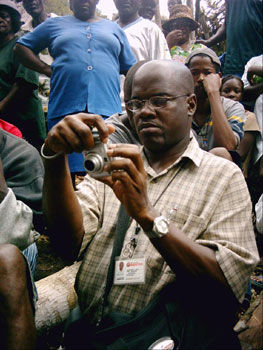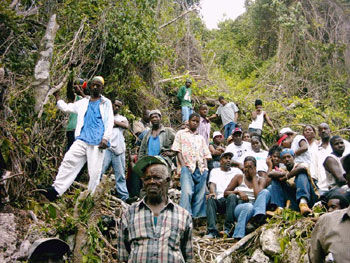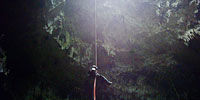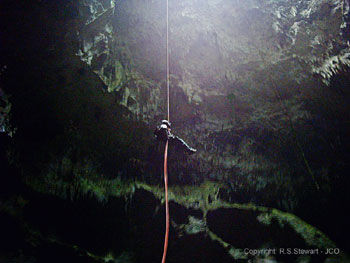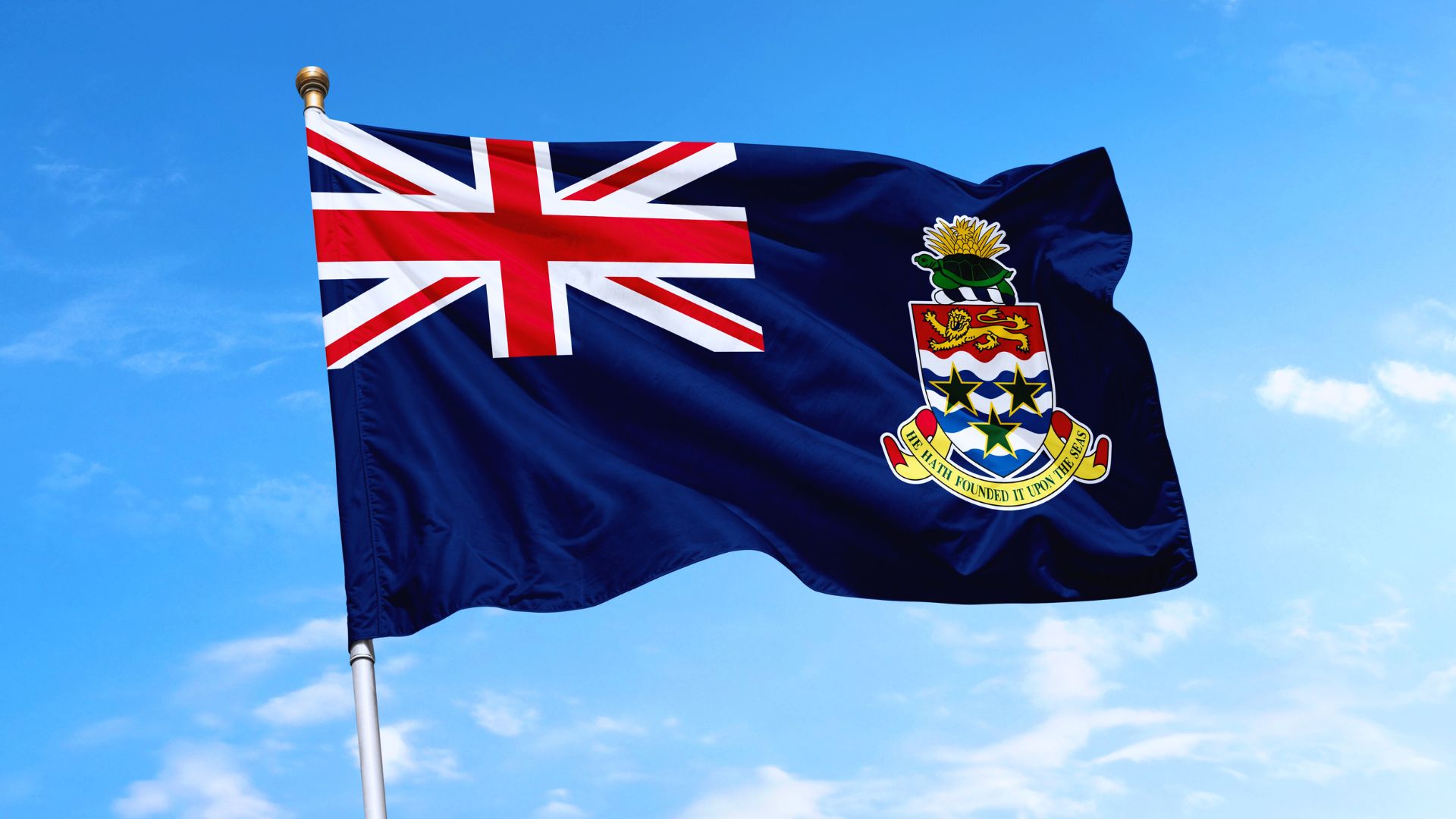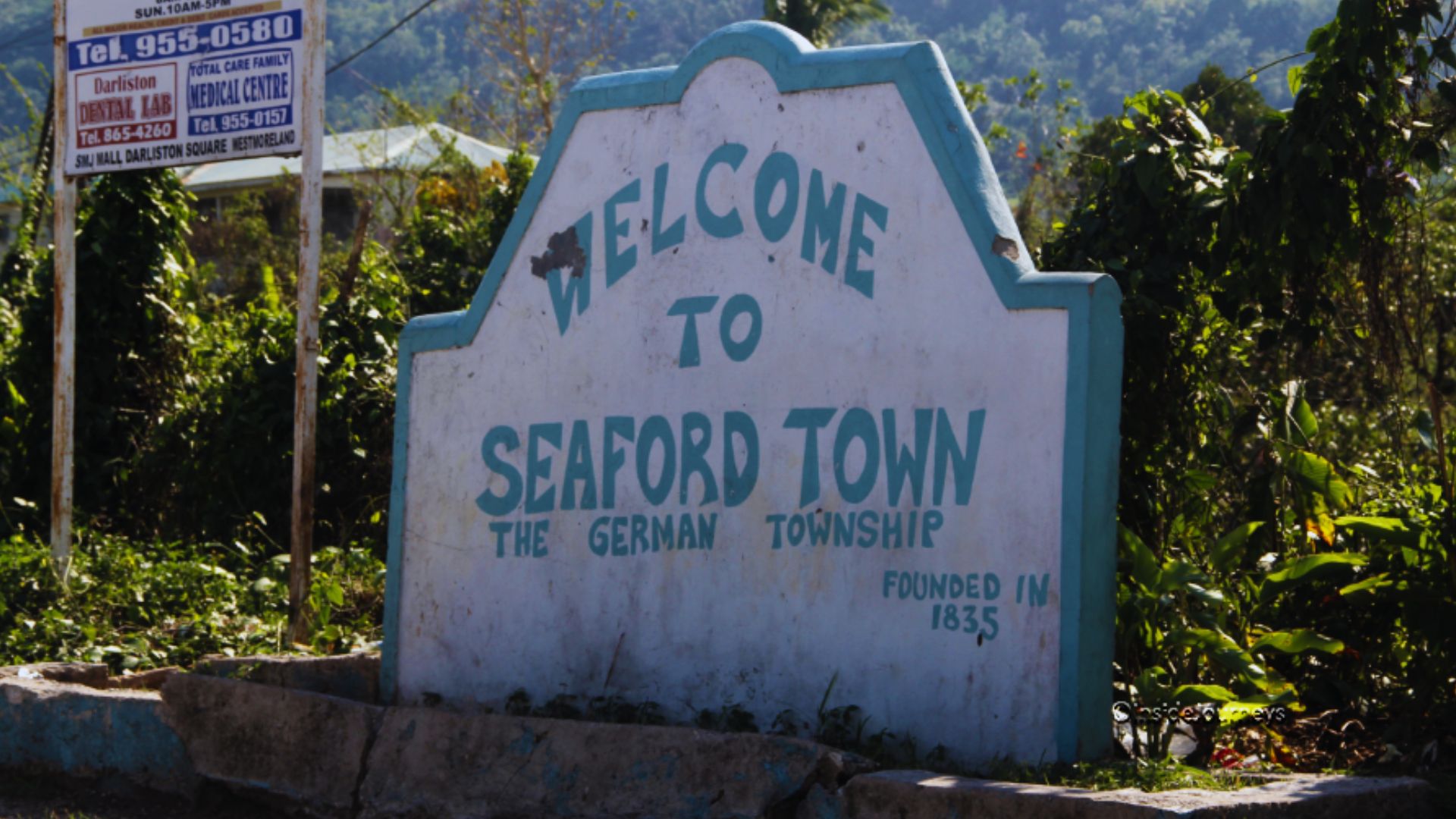CHAPTER 2 – Thatchfield Great Cave
My account of our visit to Thatchfield Great Cave will perhaps help to cleanse the reader’s minds of some of the more gruesome aspects of the visit to Hutchinson’s Hole that were described in Chapter 1. It also better represents our more normal caving activities, in particular, the biological factors that the Jamaican Caves Organization looks for as part of our assessment work.
Thatchfield Cave is a very beautiful, very valuable cave found in northern Saint Ann. We hope that by describing this beauty and value we do not start a stampede to it. Regular human visitation would result in great damage. We ask that if you wish to visit it, you content yourself by peering down into the giant Lighthole Entrance and leave it at that.
The following account is based substantially on my notes for Jan 25, 2004, and has been left in the same format.
Jan 25, 2004
THATCHFIELD GREAT CAVE
Field notes: R. S. STEWART
Cavers: R. S. Stewart, I. C. Conolley, S. McCall, M. Bellinger
Time in: 12:25 EST, Time out: 17:45 EST
THREAT VULNERABILITY: High
Thatchfield Great Cave is truly a great cave. The biology, hydrology, and sheer beauty of this cave make it one of the most important of the underground realms to be found on the island of Jamaica.
A visit to Thatchfield Great Cave was high on the agenda for the January, 2004 session. We had several objectives for this cave, not least of which was to do a basic assessment that would supply a biological snapshot of the condition of the cave in early 2004. Although none of the team that would visit Thatchfield on this day were biologists, an assessment process had been established, with the collaboration of the WRC, and others, that would enable simple cavers such as us to glean pertinent data from our otherwise anecdotal observations. This expedition was our first trial-run of the process and Thatchfield was a very good cave to include in this first, particularly organized, collection of data.
Thatchfield Cave was an important inclusion for several reasons: It supplies housing for one of the greatest collections of bats in Jamaica, (over the years, there has been occasional speculation about using this cave for tourism, and although it is doubtful as to whether this will ever happen, it seemed circumspect that we have a look a things before this began and note approximate bat numbers in the main roosting chambers so that there would be baseline data), we see a potential for further exploration, believing that there are perhaps extensions past the drop in the, “New Cave”, and most importantly, as cavers, this cave is as enticing as any to be found on the planet, and we of course wanted to get to know it.
On the morning of January 25, 2004, the crew headed for Thatchfield Cave. This was our second day of the expedition, the first having been spent in St James continuing the survey of Roehampton School Cave, fighting wasps at Windsor Castle Cave, and adding “Comfort Hall St James Cave” to the Register. Mark Bellinger, Ivor Conolley, and I, Stefan Stewart, had spent the night in Windsor, and despite the attractions of Miss Lilly’s Bar in Coxheath, managed to wake at a decent hour.
Today, we would be traveling in two cars. Ivor had his car, and I had the rental from Alex’s. Because I was behind the wheel of a fairly new car, with brakes that actually worked, and steering that steered, I headed out first to link with Sarah McCall who awaited us in Falmouth. Yesterday, we’d been close to two hours late and I was very intent on cutting that time back to thirty minutes. As it turned out, thanks to having no livestock or taxi induced collisions on the way, I was able to link with Sarah close to the planned-on time, (around 30 minutes late). Of course, we had to wait for Ivor and Mark to catch up, and then hit the Wholesale’s for batteries, so in the end things took their own time happening.
Shortly before noon, we arrived in Thatchfield, Saint Ann. Surprisingly quickly; we linked with a local man who knew exactly where the cave was located. Although I’d made a brief visit to Thatchfield years ago, I had little recollection of the place, and this gentleman speeded things up greatly. On the way to the cave, we learned that it was his birthday. We asked if we were taking him away from anything, but he seemed happy linking with us for the cave. By the end of the session, he still seemed happy that he had. Unfortunately, I know I have his contact info and name somewhere, but I haven’t found it yet. I believe that Ivor has it as well. He was a cool guy.
Thatchfield Great Cave has three ways in: The Lighthole, Entrance 1, and Entrance 2. The Lighthole, a rather pedestrian name for a very spectacular feature, is within 30 meters of the road that leads to the cave from Thatchfield. This is where we first made contact with the cave.
Most lightholes, of course, are merely places where a cave has reached the surface. In Jamaica, they tend to be on the order of 1 to 5 meters wide and are usually found in simple breakdown caves that occur high in hills, or in stream-passage systems that are not deeply situated. In the case of breakdown caves, a common layout is this: A large entrance is found in a saddle (or col), that leads into one, or several linked, breakdown chambers. They are very ancient caves and while they were growing upwards, the surrounding terrain was being lowered through Karst type erosion and collapse. Eventually, large chambers are formed that are at elevations well above the surrounding bottomland, and eventually they manage to cut small holes through to the top of the hill in which they have formed. The process does not stop here, but does also not proceed at as gradual a pace as it did for the hundreds of thousands of years that came before; there is a relatively rapid change from small lighthole to collapsed cave. One seldom sees the intermediate state. Because in many cases these breakdown type caves are not great in extent, consisting of only several chambers at best, when the roof comes down, that’s it for the cave. There is no more cave, just another collapsed area that has widened the saddle and has continued on its way to becoming more bottomland. The Lighthole at Thatchfield Great Cave is different.
At Thatchfield, the large chamber that carved its way up to the surface, and then collapsed, is part of a much larger system. The cave originally formed as a large river cave, long years ago. Because the limestone in which it formed is of a soft, amorphous type, the original large stream-passage has grown through percolation and breakdown to become much larger. It retains its original length, and is in fact still growing, but the early stream-passage, and its tributaries, have grown to massive proportions. The Lighthole chamber, at the upstream end, even when fallen in, was still part of a much larger system and remains part of it. Upstream, and downstream, the rest of the cave survived and continued growing. The Lighthole just became a spectacular way to access this cave
The Lighthole, unmeasured by us but about 35 m across, was how we intended to enter the cave. Although we knew that there were two small entrances to the north that would not require vertigear, the drop into this giant Lighthole pit was the most enticing way in. From the edge, because the upper part is somewhat funnel-shaped, we couldn’t see the bottom, but being fairly certain that the 60 m line would do it; we scanned for the best anchor point, the north, and then started rigging the drop. Because of the great width of the hole, we couldn’t divert the main-line away from the rock wall down which we would enter the hole, but we chose the most vertical, smoothest looking spot so we could avoid sharp edges, and tied off to a large tree.
The rope was lowered into the hole, and since I was the person who had brought the crew here, and chosen the descent point, and tied the rope, it seemed proper that I be the guinea pig and go down first. Accordingly, I harnessed up and got on-rope. As soon as I had done this, I realized that I had left my cigarettes in the car, and because I have to have a few quick puffs on a smoke before I begin every major descent, in case it is my last ever chance to do so, I had to temporarily abort the rappel. I confess, I asked Mark to run up to the car to get them for me… I felt a little guilty, him being a non-smoker, and me taking advantage of my position as the “expert”, but I was on the rope already and standard procedure for me is to get on rope, light a smoke, have several puffs, put it out, then head down, and I didn’t want to mess with the routine. I was already set to descend, my first rope-work of the session, and I didn’t want to jinx things. Mark, bless his heart, got my cigarettes; I had a few puffs, and then headed down.
After about 10 meters, I could see to the bottom of the hole. There was rope visible on the floor. Things were good. After another 5 meters, I left the wall of the pit behind as I descended into the lower, wider part of this ancient collapsed breakdown chamber. The upper part, some 35 m wide, gave way to a chamber twice as wide. The wall pulled away and the rappel became very beautiful. I slowly slid down the line, with my left hand on the figure-8 checking for heat, and felt very alive and very glad to be so. Too soon, I was at the bottom, about 45 m down.
The descender had built up some real heat by the bottom, so I tried to get the rope slacked in it as fast as possible, while not burning my hands, and after a minute was able to get off-rope. I gave a shout to those up-top that I was down and the next person could come ahead. Because of the distance, communication was difficult. I had forgotten to bring the walkie-talkies. The plan had been that Sarah would come next, then Ivor. Sarah didn’t have a lot of experience on long drops and I was concerned that it might be a little much for her first descent. It is a sad comment on my skills as an expedition leader that this didn’t truly occur to me until I was at the bottom; on this second day of the expedition, I was thinking mostly in terms of mechanics rather than the welfare of those whom I was supposed to be safe-guarding. In order to mitigate the potential damage, I moved just far enough to the side of the chamber to avoid rock fall, with the end of the rope in hand, and put tension on the line so that I could perhaps slow down an out of control rappeller. Peering upwards, I eventually saw the next person coming down.
I could soon make out that it was Mark. Mark Bellinger, American Peace Corps volunteer, and a very cool guy, had experience with Single Rope Technique. I did a turn of the rope around a leg, just in case, so I could get to it fast, and got out the camera. Looking up, this was obviously great photo potential. It was also very cool just watching him come down. I got several shots as he descended, one of which is being used extensively on the website. Mark arrived at the bottom, after having made a very controlled, very safe rappel, got off rope, and then we shouted up that we were clear. Within five minutes, we could see another person on the rope a great distance above us.
It wasn’t until the next rappeller was about a third of the way down that we could even tell who it was. Ivor was on the rope, coming down in good form, and five minutes later he was carefully detaching his hot descender from the line. We learned that Sarah had wisely decided to sit out this descent and would stay up top with the birthday boy.
We had the map for the known part of the cave, and we knew which way led to the two lower entrances and which way led further into the cave. Mark made the very good suggestion that we first find the lower entrances so that we would know if we would need to ascend the rope to get back out, or if we could just exit out the found lower entrances, thus not having to plan on time for three people to ascend 45 meters. This turned out to be an excellent suggestion.
The three of us headed to the north to seek out the other entrances. A large, level passage, of about 14 m width and 10 high, extends for about 30 m to the north and then begins to rise over boulders. This leads up to a chamber that offers steeply ascending routes to both left and right. I took the right-hand route, and after scrambling up through an ever-shrinking extension of the chamber, reached a dead-end. As I worked my way back down, Ivor worked his way to the route on the left. High in this direction, Ivor made a last climb/scramble and found a way on. This, after another 10 meters, arrived at Entrance 1. We all followed him up, and made our way out to the sunshine to have a look. Entrance 1 was quite small, about 1.5 m high and twice that wide, up about 10 m on the side of a hill. We now knew that we would not have to spend an hour or two ascending the rope to exit the cave, and we would have that much more time to spend in it. It was at this point that I redeemed myself as the expedition leader. I realized that we could easily walk around to the Lighthole entrance, pull the rope, get Sarah and our local assistant, and bring them into the cave through Entrance 1. I did just that, and not long afterwards, all five of us were assembled at Entrance 1 and heading back into the cave.
A close look inside Entrance 1 found an eleutherodactylus, (a type of frog that likes caves), but no invertebrates. This part of the cave is very dry due to it receiving a diurnal convective flow of air coming from the Lighthole. We then retraced our steps back to the Lighthole, and made our way to the other side. I took a course straight across, but Ivor moved along close to the southeast wall, finding on the way the large opening that begins the route to Entrance 2. I came back, and we had a good look. There is a drop of about 10 m into a medium sized chamber, and because our main goal was to get into the “New Cave”, we slated it for the future and carried on across the Lighthole. It should be noted that the map in JU is not terribly accurate in this part of the cave. Although I wanted to find the route to Entrance 2, it is shown on the map as branching off some distance into the chambers past the Lighthole; I’d headed straight across expecting that my search for it would begin some distance ahead. It is good that Ivor had taken the route he had, or I would have been baffled by not finding it where it was shown to be.
I was lucky in not having much weight on my back, Mark having stuffed the 60 m rope into his pack, leaving me with just some batteries, maps and clipboard. As a result, I was able to move along at a good pace.
I entered a very wide, very high passage that extended to the southwest. It is comparable in size to Wharf in Windsor Cave, or the upper level at Bristol, i.e. some 40 – 50 wide and 25 – 30 high. The crawl to the New Cave is shown on the JCC survey of 1976 as being on the southeast wall close to the end of this enormous passage, so as soon as I had the end in sight, I began to work my way along the wall, looking into low openings. This particular spot had concerned me prior to our session; it is shown as being quite low, described as a crawl, and potentially difficult to find. As it turned out, the second set of small openings low on the east wall showed a way ahead and I had it proven and flagged before the others reached where I was.
This “crawl” went undiscovered for many years. To quote from JU, it was “discovered in 1971 apparently after a blockage was washed out in a flood”.[1] Perhaps it has been washed out further since then because it is not really a “crawl”, but rather is 1 m at the lowest point, and indeed, much of the 10 m length is about 1.5 m. After this 10 m, the New Cave is reached.
The members of the Jamaican Caving Club, who in 1971 made this discovery of the New Cave, must have been astounded at what they found. After 10 m, they entered a passage some 6 m high and the same wide. Before them, it extended to the SW and obviously increased rapidly in size. They followed this, soon scrambling down over breakdown boulders, as the ceiling rose higher above them; to reach the floor of a passage as large as anything they had seen in the “Old Cave”. Further ahead, the passage grew larger. They carried on, and on, through passages, chambers, the discovery of which must have surpassed their greatest hopes. Above them, and around them, flew thousands of bats, their spectacular home seeing its first human visit. After hundreds of meters, a junction was reached. Enormous passages extended both left and right. To the right, they found more of these grand galleries that eventually led to avens. To the left they eventually reached a series of drops that led into a lower, continuing passage. What they had found this day was a “New Cave”, many times vaster than that which they had entered from, and that still presented opportunities for further exploration. Further work was done on repeat visits, but a close reading of their notes shows that the potential for new discoveries still remains.
Following in the footsteps of the JCC, we began to move ahead along this route. It was soon apparent that the bat numbers in this cave were massive. The sound of them in flight, disturbed by our presence and lights, was like that of a flowing river. I had been deceived by this at Home Away Cave in 2001, and thought that there was indeed a river ahead, but I now knew that this was not water, but bats in great numbers. This great sound of bats would persist for virtually the entire rest of the cave. In total numbers, the bat population in the New Cave far exceeds any that I have seen in other caves. It is comparable in density to the main roosting chamber at Windsor, but covers, at least, 10 times as much area. At Geneva Mountain Cave, at Dolphin Head, the density was greater, but Thatchfield is many times greater in size. Bristol, with most of the bats now eliminated, would not have compared when it was still intact. To date, Thatchfield Great Cave has the greatest numbers of bats that I have seen in a Jamaican cave, by far.
Before I go further, I must note two observations that indicate the possibility of another entrance to the cave, perhaps in the area of the avens. When we were in the crawl to the New Cave, there was a strong inward flow of air. The vast numbers of bats that roost in the New Cave are not flying though the crawl on their way in and out. There is apparently an additional undiscovered way into the New Cave. It is at least large enough for great numbers of bats to fly through. The inward flow of air at the crawl shows that an opening to the surface exists at a higher level than the crawl. At a guess, I’d say it’s at the avens. The JCC made partial ascents of the two avens and were unable to reach the top of either. They encountered steeply sloped flowstone. Flowstone shows that water was entering the cave from above. To push these routes would probably require bolts. This is an issue of etiquette more than anything else. It certainly is inviting… this is a matter that should be well discussed with all concerned before a decision is made.
Soon after the crawl, a gully is seen running through the chambers ahead. In truth, the gully begins before the crawl, but becomes more obvious as one proceeds further into the New Cave. Its route is easily traced the entire way, until it empties its seasonal waters into the series of drops at the west end of the cave. This gully is what remains of the giant river that originally carved out this system. It now flows in a channel of about 1 – 2 m width along the floor of the cave, on an irregular basis. We followed this gully, it offering in many places the best footing, until we reached the great junction where to the right are found the avens, and to the left, the drops. Centered in the middle of this junction is a stalagmite of about 2.5 m height that I flagged as a matter of form rather than necessity. There was not much chance of getting lost in this cave, the JCC map imprinted in my mind, and also printed and stored in a zip lock bag in my pack, but for the sake of appearances I tied a temporary flag on it anyway.
We turned left at this great junction, wanting to reach the verticals, downstream, which is the route that leads to the furthest known point of the cave. The passage began to diminish in height somewhat now. We soon reached what would normally be seen as the end of a distinct chamber, the first such encountered since the crawl. There hung here a spectacular upside-down forest of stalactites, close packed in the hundreds. Passing these to the right, we moved through an opening of 10 m width and 5 height into a passage that again became larger and also much muddier. The dimensions of it were reduced to some 25% of what we had left behind, the elevation steadily lowered, and the waters that reach this point had been gathered into a narrower passage and had deposited deep deposits of mud and silt. We began to run into sections that were tricky to walk through, one’s feet disappearing knee-deep into the mud. A series of 1 – 2 meter drops began and finally ended in a more serious drop of about 10 m, closely followed by another the same. These were the verticals that lead down to the lowest levels of the cave. Unfortunately, time was growing late, and there was no way we could rig this drop, have several of us descend, and return to Entrance 1 by sunset. Ivor and I had a good look to see how we would rig this drop in the future, and then we had to turn back. We will soon return to this point and carry on.
We retraced our route back out, gathering all the flagging tape that had been set on the way in. Seeing this grand passage for the second time, it enabled us to more closely look at the geomorphology of the system. The cross-section of this ancient passage is very particular; it is dome-like until it reaches to about 4 meters above the floor, and then a terrace occurs on both sides, that extends several meters into the passage. Upon this terrace there are many thin stalagmites about 1 – 1.5 m in height. There seems to have been several erosional epochs in the development of the system. The original passage was carved by a large underground river that flowed for a very long time. This was followed by a dry period represented by the terraces which were the floor of the passage. Water flow through the cave then increased again, but not to the original extent. The old, large passage was now carved lower, but by less water and thusly has a narrower cross-section. Upon the terraces, stals formed by percolation from above. Today, a narrow gully runs through it, flowing only during times of heavy rain, but perhaps awaiting another period of increased flow to begin growing again.
Biologically, this cave is of tremendous value. Invertebrates, unfamiliar to us from other caves, were noted but not identified. In particular, a beetle, and a spider, both species previously unobserved by us, (though probably not terribly rare), were present in great numbers.
This cave supplies one of the most important bat roosts on the island. This cannot be overstated.
Surprisingly, the system has not been invaded by American Roaches. This means that our cursory observations of inverts are merely the tip of the iceberg. If there are no, or few, Roaches, and there is an enormous bat population supplying food resources, then there are many more invert species lurking in there than what we observed.
The cave has been protected from the ravages of guano miners by its difficult access. No one taking rat bat dung would enter via the Lighthole. The route in from Entrance 2 is not possible for this activity. The route in from Entrance 1 is too much work. The New Cave, as a result, remains pristine.
My own personal opinion is that this cave is one of the most important on the island. If tourism were to take place, it would do great damage. We cannot recommend too strongly that this cave receive the greatest degree of protection possible.
Our return to Entrance 1 went well, but slowly. Mark Bellinger, with his offer to carry more of the gear and rope than he should of, did yeoman’s duty this day. The birthday gentleman, whose name shall be listed in these notes soon, was a great help in the speedy location of the cave and we are glad that he enjoyed the experience of seeing parts of the system that he didn’t know existed. Sarah McCall was a great help during this visit, and Ivor Conolley was his ever-dependable, observant self.
[1] A G Fincham (1997) Jamaica Underground (ISBN 976-640-055-5) The Press – University of the West Indies
Next: Part IV
In the final installment, Part IV, of this series, we will offer suggestions for those who wish to actually visit Jamaican caves. In addition to descriptions and details of Showcaves, the JCO will recommend experienced guides who can be of assistance for those who are very adventurous.
